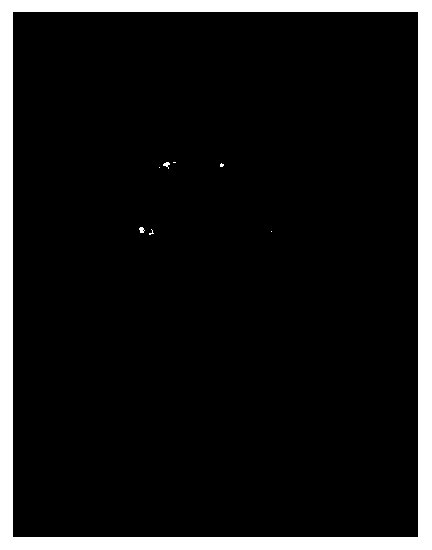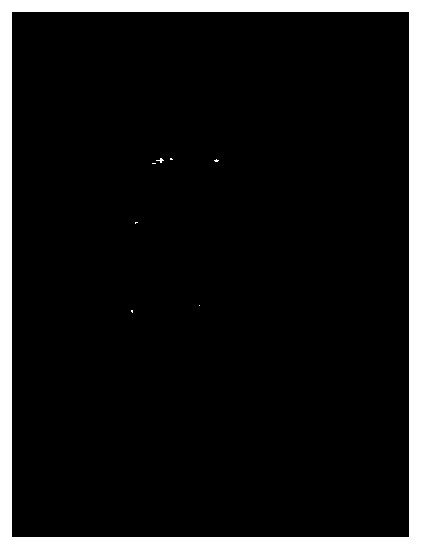Three-dimensional model deformation algorithm based on quasi-conformal mapping
A three-dimensional model, conformal mapping technology, applied in the field of computer vision, can solve problems such as difficult deformation, poor model processing effect, and rotation sensitivity.
- Summary
- Abstract
- Description
- Claims
- Application Information
AI Technical Summary
Problems solved by technology
Method used
Image
Examples
Embodiment 1
[0072] Such as figure 1 As shown, a 3D model deformation algorithm based on quasi-conformal mapping, which includes the following steps:
[0073] Step 1, such as figure 2 As shown, the input two-dimensional face image is preprocessed, and the contour line of the object in the image and the feature point set {t:} are extracted. The extracted contour line is as follows image 3 shown; where the feature point set {t:} is obtained by preprocessing the target image, extracting the information of the contour and feature points, and the extraction of feature points is as follows Figure 4 shown.
[0074] Step 2, use the 3D model retrieval method to find the model with the highest similarity with the target image face in the MeshDGP 3D model library as the deformed 3D source model, and obtain the information of the number of vertices and the number of faces of the retrieved model, which are respectively recorded as V n ={v 1 , v 2 , v 3 ,...,v n}, f m ={f 1 , f 2 , f 3 ,.....
Embodiment 2
[0107] The difference between embodiment 2 and embodiment 1 is:
[0108] The target 2D image is a 2D ear image, and the retrieved 3D source model is an ear model, such as Figure 8 Shown are the renderings of the 2D ear mesh model and the 2D plane disc parameterized by the 3D source model, where the left picture is the rendering of the 2D ear grid model parameterized to the 2D plane disc, and the right picture is Rendering of the parameterization of the 3D source model of the ear to a 2D planar disk. Select 3 vertices in the earring part as control points, and perform stretching and translation operations. The two-dimensional model before and after deformation is as follows: Figure 9 shown, where Figure 9 (a) is the two-dimensional image before deformation, Figure 9 (b) is the deformed two-dimensional image, and the final three-dimensional model result image obtained by deforming the ear model is as follows Figure 10 shown. ε=0.001 in step 6.3, m=200 in step 7.3.
Embodiment 3
[0110] The difference between embodiment 3 and embodiment 1 is:
[0111] The target 2D image is a 2D wrinkled old man image, and the retrieved 3D source model is a wrinkled old man model, such as Figure 11 Shown is the rendering of the 2D folded elderly mesh model and the 2D plane disk parameterized by the 3D source model, where Figure 11 (a) is the effect diagram of parametrizing the 2D folded elderly mesh model to a 2D plane disc, Figure 11 (b) The rendering of the parameterization of the 3D source model of the wrinkled old man to the 2D flat disk. Select a vertex in the wrinkled old man's lips as a control point to make the mouth corners of the model open. The two-dimensional model before and after deformation is as follows: Figure 12 shown in , where Figure 12 (a) is the two-dimensional image before deformation, Figure 12 (b) is the deformed two-dimensional image, and the final three-dimensional model result image obtained by deformation of the wrinkled elderly m...
PUM
 Login to View More
Login to View More Abstract
Description
Claims
Application Information
 Login to View More
Login to View More - R&D
- Intellectual Property
- Life Sciences
- Materials
- Tech Scout
- Unparalleled Data Quality
- Higher Quality Content
- 60% Fewer Hallucinations
Browse by: Latest US Patents, China's latest patents, Technical Efficacy Thesaurus, Application Domain, Technology Topic, Popular Technical Reports.
© 2025 PatSnap. All rights reserved.Legal|Privacy policy|Modern Slavery Act Transparency Statement|Sitemap|About US| Contact US: help@patsnap.com



